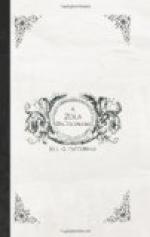HOURDEQUIN (MADEMOISELLE), the second child of Alexandre Hourdequin. She was a delicate and charming girl, tenderly loved by her father. She died young, a short time after her mother. La Terre.
HOUTELARD, a fisherman of Bonneville, whose house was washed away after the destruction by the sea of the barricade erected by Lazare Chanteau. La Joie de Vivre.
HUBERT, a chasuble-maker who lived in a house immediately adjoining the cathedral of Beaumont. “For four hundred years the line of Huberts, embroiderers from father to son, had lived in this house.” At twenty years of age he fell in love with a young girl of sixteen, Hubertine, and as her mother refused to give her consent to their union they ran away and were married. On the morning after Christmas, 1860, he found the child Angelique lying in a fainting condition in the snow outside the cathedral door. Having taken her into his house, he and his wife soon became attached to her, and as they had no children, ultimately adopted her as their daughter. Le Reve.
HUBERTINE, wife of the preceding. At the age of sixteen she fell in love with Hubert, the chasuble-maker, and as her mother, widow of a magistrate, would not give her consent, they ran away and were married. A year later she went to the deathbed of her mother, who, however, disinherited her and gave her her curse. “So affected was she by the terrible scene that her infant, born soon after, died.” The Huberts had no other children, and after twenty-four years they still mourned the little one they had lost. She warmly approved of the adoption by her husband and herself of the foundling child Angelique, whom she treated with the greatest kindness. From the bitterness of her own experience she had a horror of disobedience to parents, and when she found that the consent of Monseigneur d’Hautecoeur could not be obtained to a marriage between his son Felicien and Angelique, she did all she could to sever the lovers. In this she was successful for a time, until the illness of Angelique, and her miraculous recovery, induced the Bishop to give his consent. Le Reve.
HUE (M.) a retired Government official, who was a sincere lover of art. He was unfortunately not rich enough to be always buying pictures, and could only bewail the blindness of the public which allowed a genius to die of starvation; for he himself, convinced, had selected Claude Lantier’s crudest works, which he hung by the side of his Delacroix, predicting an equal fortune for them. L’Oeuvre.
HUGON (MADAME), mother of Philippe and Georges Hugon. She was the widow of a notary, and lived quietly at Fondettes, an old family property near Orleans, but had retained a house in Paris in Rue de Richelieu. She had been an old friend of the Marquise de Chouard, and was on intimate terms with her daughter, the Comtesse Sabine. A woman of high principles, she believed that one should overlook much in others in order that something might be pardoned in oneself. In this she contrasted strongly with her old friend the Marquis de Chouard, who professed the most rigorous virtue while he secretly lived a shameful life. She was, however, unable to bear with equanimity the eccentricities of Nana, her neighbour in the country, who led Philippe Hugon into dishonour, and his brother Georges to suicide. Nana.




